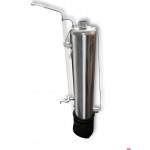
Common Mistakes in Autoclaving
Despite the ease of using household autoclaves, some people are prone to making mistakes. This is problematic because improper use can ruin your preserves and lead to product loss. To avoid mistakes in autoclaving, follow the rules described in the autoclave's instruction manual.
Mistake #1. Too much water in the autoclave. Ignoring the instructions and filling the autoclave with water completely or just more than 2 cm above the tops of the jars will definitely spoil the entire preservation process. Water in the autoclave expands, and if the required air gap is not left, it will create too high a pressure in the tank, leading to the activation of the safety valve.
Mistake #2. The initial pressure in the autoclave needs to be exactly 1 atm, no more, no less. If you pump in less than 1 atm, it might be insufficient to keep the jar lids in place. If the starting pressure is more than 1 atm, the working pressure in the tank will be above normal and will trigger the safety valve.
Mistake #3. Always leave extra space in the jar, 2 cm from the lid. During strong heating, food products expand and can push the lid off. To avoid this, leave 2-3 cm of space, which will cause the lids to be drawn inwards instead.
Mistake #4. Lack of water in the device. Regardless of the number of jars or the volume of the autoclave, it is necessary to fill it with water to cover all jars by 2 cm. Even heating of the jars is achieved through heated water, which circulates throughout the device. The water cools gradually, providing a gradual cooling of the preserves.
Mistake #5. Opening the autoclave before it has fully cooled. After the preservation process and turning off the heat, many people want to open the device immediately to check the contents. You should not unscrew the nuts until the autoclave has completely cooled down. The pressure inside the device corresponds to the pressure inside the jars. If you open the autoclave prematurely, the lids may come off. Always let the device cool completely before opening the lid.
Mistake #6. Lack of sealing. To ensure sealing, the nuts must be tightened evenly. Tighten them in a cross pattern using a wrench. Ignoring this can lead to the lids coming off or the pressure rising too slowly or not at all. With proper sealing, the pressure inside the jars will gradually increase.
Mistake #7. Incorrect jar sealing. Before the procedure, soak the metal lids in boiling water until the sealant softens. Choose high-quality lids from a trusted manufacturer, free from damage.
Mistake #8. Incorrect autoclave mode. Pay attention to what is specified in the preservation recipes. Do not cook fruits under pressure for an hour at 120°C if the recipe instructions say 15 minutes at 100°C. Do not forget about the autoclave; do not leave it on for too long to avoid overheating the preserves.
We hope you have understood how to properly use an autoclave. For home canning, choose the best quality autoclaves from domestic manufacturers.
Read also:
- Autoclave Operating Modes
- What is an Autoclave
- Hydraulic Testing of Autoclaves
- How to Use an Autoclave
- How to Choose an Autoclave









